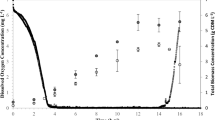Abstract
The fadBA operon in the fatty acid β-oxidation pathway of P. putida KCTC1639 was blocked to induce a metabolic flux of the intermediates to the biosynthesis of medium chain-length PHA (mcl-PHA). Succinate at 150 mg l−1 stimulated cell growth and also the biosynthesis of medium chain-length-polyhydroxyalkanoate. pH-stat fed-batch cultivation of the fadA knockout mutant P. putida KCTC1639 was carried out for 60 h, in which mcl-PHA reached 8 g l−1 with a cell dry weight of 10.3 g l−1.




Similar content being viewed by others
References
Brandl H, Gross RA, Lenz RW, Fuller RC (1988) Pseudomonas oleovorans as a source of poly(β-hydroxyalkanoates) for potential applications as biodegradable polyesters. Appl Environ Microbiol 54:1977–1982
Fiedler S, Steinbuchel A, Rehm BHA (2002) The role of the fatty acid β-oxidation multienzyme complex from Pseudomonas oleovorans in polyhydroxyalkanoate biosythesis: molecular characterization of the fadBA operon from P. oleovorans and of the enoyl-CoA hydratase genes phaJ from P. oleovorans and Pseudomonas putida. Arch Microbiol 178:149–160
Garcia B, Olivera ER, Minambres B, Fernandes-Valverde M, Canedo LM, Prieto MA, Garcia JL, Martinez M, Luengo JM (1999) Novel biodegradable aromatic plastics from a bacterial source. J Biol Chem 274:29228–29241
Green PR, Kemper J, Schechtman L, Guo L, Satkowski M, Fiedler S, Steinbuchel A, Rehm BHA (2002) Formation of short chain length/medium chain length polyhydroxyalkanoate copolymers by fatty acid β-oxidation inhibited Ralstonia eutropha. Biomacromolecules 3:208–213
Hideaki M, Hiroshi Y, Taiji N (2000) Assignment of the substrate-selective subunits of the MexEF-OprN multidrug efflux pump of Pseudomonas aeuruginosa. Antimicrob Agents Chemother 44:658–664
Ishikawa M, Mikami Y, Usukura J, Iwasaki H, Shinagawa H, Morikawa K (1997) Reconstitution, morphology and crystallization of a fatty acid β-oxidation multienzyme complex from Pseudomonas fragi. J Biochem 328:815–820
Kim TK, Jung YM, Vo MT, Shioya S, Lee YH (2006) Metabolic engineering and characterization of phaC1 and phaC2 genes from Pseudomonas putida KCTC1639 for overproduction of medium-chain-length polyhydroxyalkanoate. Biotechnol Prog 22:1541–1546
Kim TK, Vo MT, Shin HD, Lee YH (2005) Molecular structure of the PHA synthesis gene cluster from new mcl-PHA producer Pseudomonas putida KCTC1639. J Microbiol Biotechnol 15:1120–1124
Langenbach S, Rehm BHA, Steinbuchel A (1997) Functional expression of the PHA synthase gene phaC1 from Pseudomonas aeruginosa in Escherichia coli results in poly(3-hydroxyalkanoate) synthesis. FEMS Microbiol Lett 150:303–309
Lim SJ, Jung YM, Shin HD, Lee YH (2002) Amplification of the NADPH-related genes zwf and gnd for the oddball biosynthesis of PHB in an E. coli transformant harboring a cloned phbCAB operon. J Biosci Bioeng 93:543–549
Oeding V, Schlegel HG (1973) β-Ketothiolase from Alcaligenes eutropha H6 and its significance in the regulation of poly-β-hydroxybutyrate metabolism. J Biochem 134:243–248
Olivera ER, Carnicero D, Garcia B, Minambres B, Moreno MA, Canedo L, DiRusso CC, Naharro G, Luengo JM (2001) Two different pathways are involved in the beta-oxidation of n-alkanoic and n-phenylalkanoic acids in Pseudomonas putida U: genetic studies and biotechnological applications. Mol Microbiol 39:863–874
Park SJ, Park JP, Lee SY (2002) Metabolic engineering of Escherichia coli for the production of medium-chain-length polyhydroxyalkanoates rich in specific monomers. FEMS Microbiol Lett 214:217–222
Qi Q, Steinbuchel A, Rehm BHA (1998) Metabolic routing towards polyhydroxyalkanoic acid synthesis in recombinant Escherichia coli (fadR): inhibition of fatty acid β-oxidation by acrylic acid. FEMS Microbiol Lett 167:89–94
Schweizer HP, Hoang TT (1995) An improved system for gene replacement and xylE fusion analysis in Pseudomonas aeruginosa. Gene 158:15–22
Shin HD, Lee JN, Lee YH (2002) In vivo blending of medium chain length polyhydroxy-alkanoates and polyhydroxybutyrate using recombinant Pseudomonas putida harboring phbCAB operon of Ralstonia eutropha. Biotechnol Lett 24:1729–1735
Simon R, O’Connell M, Labes M, Puhler A (1986) Plasmid vector for the genetic analysis and manipulation of rhizobia and other Gram-negative bacteria. Meth Enzymol 118:640–659
Acknowledgement
This work was supported by the Basic Research Program (R01-2003-000-10742-00) of the Korea Science and Engineering Foundation.
Author information
Authors and Affiliations
Corresponding author
Rights and permissions
About this article
Cite this article
Vo, M.T., Lee, KW., Kim, TK. et al. Utilization of fadA knockout mutant Pseudomonas putida for overproduction of medium chain-length-polyhydroxyalkanoate. Biotechnol Lett 29, 1915–1920 (2007). https://doi.org/10.1007/s10529-007-9476-5
Received:
Revised:
Accepted:
Published:
Issue Date:
DOI: https://doi.org/10.1007/s10529-007-9476-5




